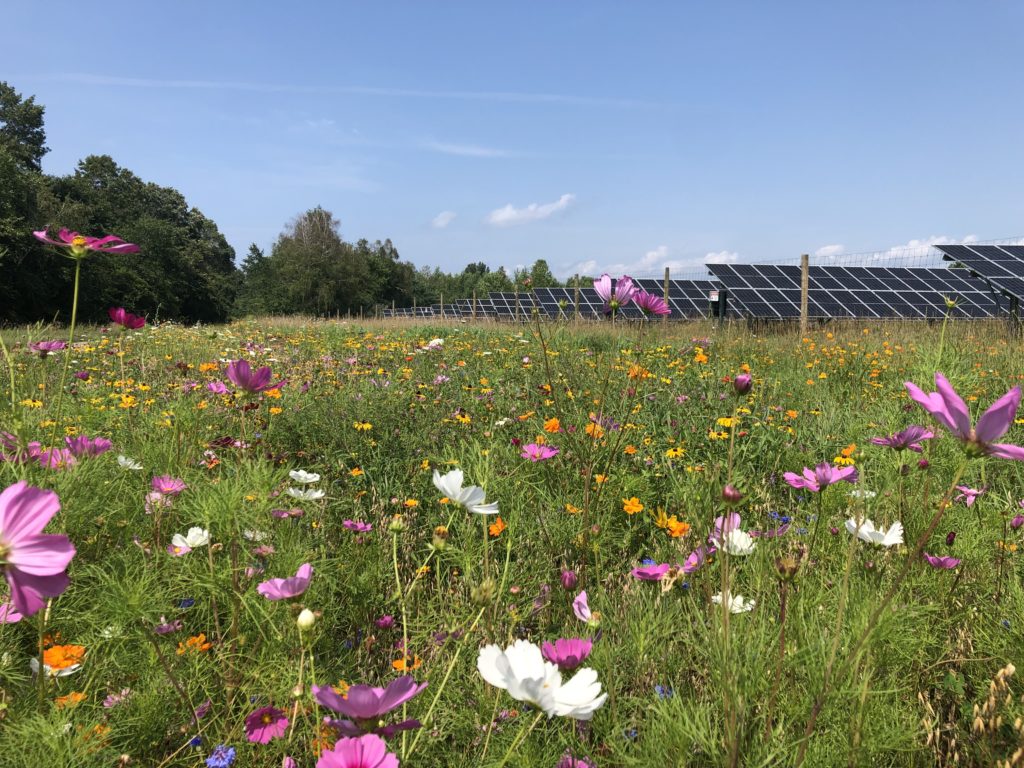With agrivoltaics, solar sites harvest more than just clean energy
Agriculture and clean energy have something in common: The best land for harvesting crops also happens to be the best space for harnessing solar power. To produce both, you need stable soil, open sky, and plenty of sunshine. Fortunately, the same land can be used for both simultaneously.
Agrivoltaics refers to the practice of utilizing a site for both solar photovoltaic power generation and agricultural activities. This dual land use not only contributes to a more sustainable future, it also provides bilateral benefits for each endeavor.
Crop production + power production
The land under and around solar panels can fulfill a wide variety of agricultural functions. It can be used for food growing, beekeeping, animal husbandry, or even installing greenhouses. Another option is planting habitat that supports pollinator populations, like bees and butterflies, which have been declining due to insecticide use, climate change, and human encroachment.
Pollinator-friendly vegetation also has advantages for crop production, both onsite and in neighboring fields. It’s not uncommon for nearby farmers to see an increase in their crop yields thanks to the greater number of pollinators venturing over to fertilize their crops. Solar sites can also be used as forage for local farmers to graze their livestock. Promoting regenerative agriculture through rotational grazing not only cuts down on site maintenance costs, but builds healthy soil.
These plants improve soil stability and remove carbon from the atmosphere. Their longer root systems help mitigate erosion, storm water runoff, and frost heaves, while sequestering substantial amounts of carbon below ground.

Benefits for solar companies, benefits for local communities
As an organization that builds durable partnerships to drive a clean energy future, Greenbacker is thrilled at the ecological benefits agrivoltaics can provide. As long-term owner-operators, we have a vested interest in how it financially benefits both our fleet of solar energy assets and the local communities our projects will call home for multiple decades.
Because agrivoltaic practices tend to replace the traditional turf grass groundcover installed on solar sites, they help reduce operation and maintenance costs. Grazing sheep can reduce onsite costs associated with both mowing and dethatching (i.e., breaking down dead vegetation). Planting pollinator habitat reduces other vegetation and pest management expenses—particularly compared to the more maintenance-heavy turf grass—more than offsetting its upfront planting expenses. It’s even been found that the cooler microclimates this habitat generates can improve solar panel efficiency.1
Agrivoltaics projects can also provide additional revenue streams in the community. Local landowners can receive land lease payments for projects built on their property. Farmers can supplement their income by leasing their sheep or cows to graze a solar site; at the same time, they reduce their own livestock feed costs, as well as wear and tear to their own pastureland. Municipalities also stand to gain additional tax revenue from these projects.
The economics of widespread agrivoltaics
While its positive impact is clear, understanding the specific economics and logistics of agrivoltaics is necessary to effectively—and sustainably—deploy it at scale in our fleet and across the industry. Greenbacker is working with some of the country’s top researchers to do just that.
We’re collaborating with the National Renewable Energy Laboratory and Argonne National Laboratory on the Solar Practices Integrated with Rural Economies and Ecosystems (InSPIRE) project. This study seeks to quantify the benefits that pollinator-friendly solar projects have on local agricultural yields, as well as how low-impact solar can improve a site’s soil quality, carbon storage, stormwater management, microclimate conditions, and solar efficiencies.
Our 88-acre solar project in Sturgis, MI is part of a three-year study by Argonne National Laboratory and the Energy Resources Center at the University of Illinois at Chicago. The purpose of this research is to develop decision-making tools for solar-pollinator habitat projects. Guidance such as planting manuals, cost/benefit calculators, and native seed-mix selection tools can help address critical stakeholder concerns such as project cost, return on investment, and site-specific constraints.

Project design with agrivoltaics in mind
Greenbacker prioritizes agrivoltaics and other nature-based land management solutions at every stage of a renewable energy project’s life cycle, from contracting and permitting to construction and power production.
We design sites with rows that are wide enough to accommodate agricultural maintenance equipment and with appropriate vegetation to accommodate panel height. We build in land access for farmers to bring their livestock and beekeepers to tend to their apiaries. We ensure secure fencing to protect grazers from predators.
We take those steps because agrivoltaics is a crucial component of a sustainable future. It’s a triple-bottom-line scenario with financial, environmental, and social benefits for ourselves and the communities our projects operate in. And with roughly 370 million acres of agricultural farmland set to change hands as farmers retire over the next ten to 15 years,2 there’s a huge opportunity on the horizon. Not only can agrivoltaics help protect the livelihood of rural communities by increasing farmland resilience and promoting regenerative agriculture, but it can build a cleaner, cheaper future for the agriculture and energy industries.
1 Kirk Siegler, “This Colorado 'solar garden' is a farm under solar panels,” NPR, November 14, 2021.
2 “2021 Transition Recommendations,” American Farmland Trust.